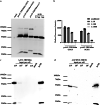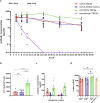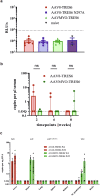Influence of AAV vector tropism on long-term expression and Fc-γ receptor binding of an antibody targeting SARS-CoV-2
- PMID: 39009807
- PMCID: PMC11250830
- DOI: 10.1038/s42003-024-06529-3
Influence of AAV vector tropism on long-term expression and Fc-γ receptor binding of an antibody targeting SARS-CoV-2
Abstract
Long-acting passive immunization strategies are needed to protect immunosuppressed vulnerable groups from infectious diseases. To further explore this concept for COVID-19, we constructed Adeno-associated viral (AAV) vectors encoding the human variable regions of the SARS-CoV-2 neutralizing antibody, TRES6, fused to murine constant regions. An optimized vector construct was packaged in hepatotropic (AAV8) or myotropic (AAVMYO) AAV capsids and injected intravenously into syngeneic TRIANNI-mice. The highest TRES6 serum concentrations (511 µg/ml) were detected 24 weeks after injection of the myotropic vector particles and mean TRES6 serum concentrations remained above 100 µg/ml for at least one year. Anti-drug antibodies or TRES6-specific T cells were not detectable. After injection of the AAV8 particles, vector mRNA was detected in the liver, while the AAVMYO particles led to high vector mRNA levels in the heart and skeletal muscle. The analysis of the Fc-glycosylation pattern of the TRES6 serum antibodies revealed critical differences between the capsids that coincided with different binding activities to murine Fc-γ-receptors. Concomitantly, the vector-based immune prophylaxis led to protection against SARS-CoV-2 infection in K18-hACE2 mice. High and long-lasting expression levels, absence of anti-drug antibodies and favourable Fc-γ-receptor binding activities warrant further exploration of myotropic AAV vector-based delivery of antibodies and other biologicals.
© 2024. The Author(s).
Conflict of interest statement
D.G. has filed a patent application on the myotropic AAV capsid; S.S. and C.T. are employees of the company Revvity Gene Delivery GmbH offering vector production services. The remaining authors declare no competing interests.
Figures







Similar articles
-
Genetic barrier to resistance: a critical parameter for efficacy of neutralizing monoclonal antibodies against SARS-CoV-2 in a nonhuman primate model.J Virol. 2024 Jul 23;98(7):e0062824. doi: 10.1128/jvi.00628-24. Epub 2024 Jun 20. J Virol. 2024. PMID: 38899895 Free PMC article.
-
Seroprevalence of binding and neutralizing antibodies against 18 adeno-associated virus types in patients with neuromuscular disorders.Front Immunol. 2024 Sep 27;15:1450858. doi: 10.3389/fimmu.2024.1450858. eCollection 2024. Front Immunol. 2024. PMID: 39399494 Free PMC article.
-
Application of polyploid adeno-associated virus vectors for transduction enhancement and neutralizing antibody evasion.J Control Release. 2017 Sep 28;262:348-356. doi: 10.1016/j.jconrel.2017.08.005. Epub 2017 Aug 5. J Control Release. 2017. PMID: 28789965 Free PMC article.
-
Mapping an Adeno-associated Virus 9-Specific Neutralizing Epitope To Develop Next-Generation Gene Delivery Vectors.J Virol. 2018 Sep 26;92(20):e01011-18. doi: 10.1128/JVI.01011-18. Print 2018 Oct 15. J Virol. 2018. PMID: 30089698 Free PMC article.
-
Anti-AAV Antibodies in AAV Gene Therapy: Current Challenges and Possible Solutions.Front Immunol. 2021 Mar 17;12:658399. doi: 10.3389/fimmu.2021.658399. eCollection 2021. Front Immunol. 2021. PMID: 33815421 Free PMC article. Review.
References
Publication types
MeSH terms
Substances
Grants and funding
LinkOut - more resources
Full Text Sources
Medical
Miscellaneous

